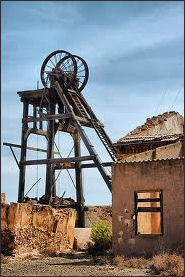La Union’s Blue, Pink and Yellow Mines
When you think of Southern Spain, you think sun, sea, sand and sangria. You certainly do not think of mining. Yet the area was once a rich mining area, in particular the coast of Murcia. This area has a rich mining heritage, which has shaped the local community in some surprising ways. The main mining area has a strange landscape. It is very scrubby, so you can see the rocks, which are multi coloured. From a distance, the hills are a patchwork of greys, blues, yellows and pinks. It is a unique landscape.
La Union’s and Portman’s multicoloured landscape is down to the fact that the land holds many riches. Over the past 3000 years, galena, sphalerite, magnetite, pyrite, lead, zinc, silver, blue fluorspar and greenalite have all been mined in the area. Exactly when mining started in the area is hard to pin down, but there is evidence that organised mining was taking place in the area in pre-Roman times. The fact mining has taken place in the area for so long and so many different ores and rocks have been mined here means that there is every kind of mine you can think of here. You can see cave mines, shaft mines, drift mines and open pits dating from different eras all using different mining techniques. Some of the mine buildings are even built in the Cornish style.
As well as the mines, you can see many processing facilities. Much of the ore was processed on site. During the 1950s numerous pools were built, which even today are full of multicoloured water. They look like huge bright red or blue puddles. Mining activity in the area started to slow during the late 60s and early 70s. The price of metals fell and the cost of labour rose. By around 2001 mining ceased in the area despite the fact that deposits that could be mined are still present. The future of the area is difficult to determine. Every now and again large companies express an interesting in mining the area again. It seems likely mining will take place here, at some point.
The mines have had a huge impact on the area and shaped the local community as well as the landscape. These mines bought all kinds of people to the area. It even pulled three small villages together to form a new town, aptly called La Union. La Union also became a centre for crafts. Hundreds of small workshops used the local metals and stones to make high quality and beautiful objects that were distributed across the world via the nearby port of Cartagena. Over the centuries, people have come from all parts of the world to work in the area. It is one of the few places outside of Wales where Welsh is spoken. Admittedly, by a tiny group of people, but it is spoken in the area.
Perhaps the most surprising thing about these mines is the impact they are still having on the local economy and the area’s population. In 1987, the tourist potential was realised and a mining museum opened in the town. Around the same time, the town began to promote the miners singing festival that had been taking place since 1961. It is thought that miners who were originally from the UK started the tradition in the area. Today, the mining singing festival is a huge draw. The town also hosts a very popular mineral fair. In 2010, a new mining museum opened which allows visitors to tour an actual mine. For now, the curious mines of La Union are not operating, but they are still bringing jobs and cash to the community. The area is a great example of the positive long-term impact mining can have on a community.
